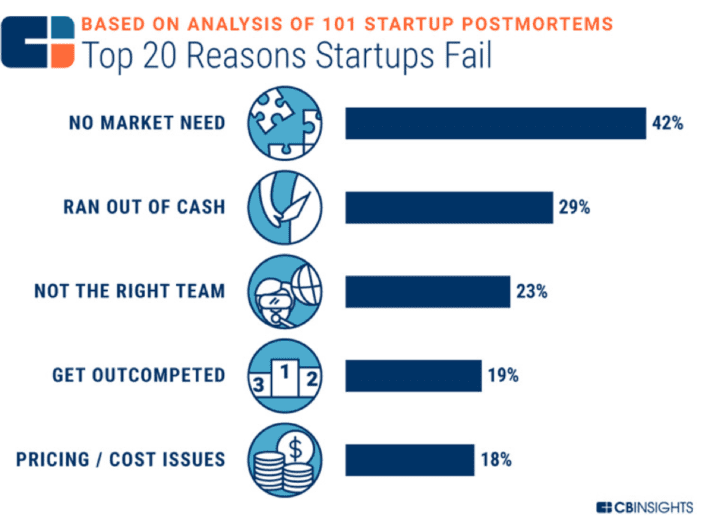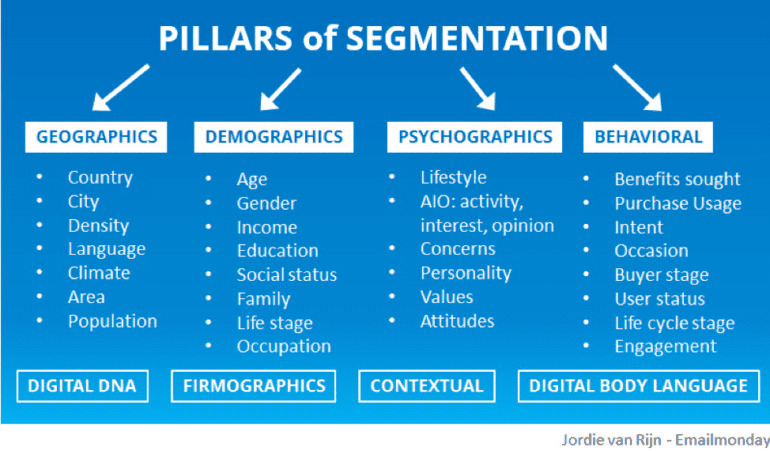At their crux, startups are born from an idea. More specifically, they’re initiated when a group of like-minded business leaders come together to find a creative and unique solution to an issue. In some cases, it’s a pre-existing problem that others in the industry are also trying to solve with their own companies. Other times, a startup is created to meet a need that we didn’t even know we had. Take Pinterest, for example. We didn’t know how powerful, interactive and informative a collection of inspirational squares could be until we hopped on the website for the very first time and placed our first “pin.”
Regardless of the “why” behind a startup, there then begs a second question: “Who?” Small businesses succeed because enough people believe in them, patronize them and tell others about them. Before investing time, money and resources into further developing a business idea, purchasing supplies or building capital, startup leaders must determine who they’re actively trying to attract and sell to with their business proposition. Understanding and analyzing the target audience isn’t just a nice-to-have part of any company plan. It should be the very first chapter, as it sets the stage for the subsequent steps that follow.
Had Pinterest marketed its services to 65-year-old men in business suits rather than the crafty crowd, its profitability and longevity might have been in question. Yet, that’s one example of a brand that knows its niche through and through. From Uber to Airbnb and a slew of others in between, the same holds true for any startup that’s managed to make it past the dreaded fate that 90% experience and join the elusive ranks of the 10% that hold steady. Yet, finding your customer base is relatively simple when you’re an established business. You can look at others in your space and see who they’re selling to. What’s working and what isn’t? Which outreach strategies and ideas can you tweak to make your own?
But, where do you turn when you’re disrupting an entirely new space? What do you do when your startup is branching out into unknown territory and you’re not exactly sure who will be interested? In these cases, finding your target audience might be a little more complicated, but it’s not impossible.
Why Target Audience Analysis is Important
Especially if you’re in the early stages of brainstorming your startup, you might wonder why it’s necessary to invest marketing spend on audience analysis. After all, you already know that the average marketing costs for a startup can encompass around 20% to 25% of your overall revenue. Why allocate that amount toward extensively reviewing the “who” behind your advertising strategy?
The answer is simple: If you don’t perform this step now, your later marketing strategies, no matter how elaborate or expensive, will fail to reach their full potential. You have to know who you’re selling to and why before you can move forward with a business plan, talk to investors or take another step forward. If not, your conversion rates won’t be the only numbers that reveal the full scope of this missed potential. You also risk having sky-high customer acquisition costs, as well. The reality is that not everyone will use or even be interested in your product, so it’s critical to find those who will. Otherwise, you’re marketing to an audience of “everyone” and that’s an unwise way to spend any marketing dollar, whether you’re a fledgling small business or a Fortune 500 success story.
In fact, according to industry research, the top reason that startups fail is that there is no market need for the product or service they’re advertising. This accounts for 42% of all unsuccessful startups.

Why Startups are Easy, Hard and Mostly Fail: Damburst
This first reason alone sheds light on why it’s important to invest in market analysis before anything else. If you determine there’s not an actual need for the solution you’re developing, it’s best to figure that out now before you move too far into the costly, stressful and time-consuming endeavor that is building a startup from the ground up.
[insert page=’5-things-you-must-do-to-increase-your-social-media-visibility’ display=’single-related-article-02.php’]
To avoid reaching pitfall #2, which is running out of money, let’s discuss how to find your niche at the onset.
1. Start wide, then narrow.
You don’t have to begin with a laser-focused perspective on who your target buyer is. You don’t even need to create a buyer persona just yet. Rather, begin the process by focusing on broad segments of the population that you think might gravitate toward your company. This might mean saying “Women in the United States between the ages of 22-40.” From there, you may segment later into stay-at-home moms, career women, outdoor enthusiasts, devoted crafters, and more.
Yet, beginning with a simple gender, location, age basis is often an ideal place to start. Already, by doing this step alone, you’ve narrowed down your audience and shifted your focus away from “everyone” to a more specific subset. Keep in mind, this doesn’t mean that 65-year-old men are absolutely prohibited from reaching your brand. It simply means you’re not spending valuable advertising dollars to reach that demographic at this point because they’re less likely to convert.
Take, for example, the ad campaign ran by Barbie in 2015. Titled “Imagine the Possibilities,” it depicted a young girl taking on myriad roles reserved for grown-ups, from college professor to sports coach to veterinarian. The scenes are sweet and tinged with humor as real-life witnesses interact with this pint-sized phenom who informs museum guests that one particular dinosaur fossil is “one year old.” At the close of the commercial, the same girl is shown simply playing with her dolls, acting out and imagining all of the aforementioned scenes.

Imagine the Possibilities: Barbie
Though this is far from a startup, it reveals the importance of properly branding to a target audience. The main character in the commercial is a little girl, no older than seven, who is the ideal target customer for the Barbie brand. This campaign wasn’t created to reach anyone other than those tykes, and their parents watching alongside of them. The commercial was narrowly focused, but that’s the intent. It was also wildly successful, winning the brand a coveted Webby Award in 2016 by the International Academy of Digital Arts and Sciences (IADAS).
[insert page=’growth-hacking-a-new-approach-to-hyper-growth’ display=’single-related-article.php’]
2. Learn from others.
There’s power in listening, especially when it’s to your competition. Though you’re technically going after the same market share, there’s likely room on the table for all of you to succeed. That’s because, regardless of how innovative your offering is, there’s already an industry either centered on or similar to what you’re providing.
To this end, it’s important to research how your like-minded peers are approaching the same issue you’re trying to navigate. What’s working for them? What needs adjusting? Of course, accessing this information might not be as quick or simple as you think. Rather, it will require immersing yourself in their outreach and promotional materials. Join their e-mail newsletter lists, follow them on social media and spend some time on their website and subpages. How are they wording their materials? What strategies are they deploying to convert on-the-fence followers? How has the virtual response been? Do people seem interested?
Take that feedback to your own drawing table and figure out how you can customize the successful and effective methods to make them your own, and how you can improve upon any weak areas you find along the way. The idea isn’t to undermine your competitors along the way, but to learn from them and use that knowledge to build up your brand such a way that the entire industry benefits.
[insert page=’3-ways-to-improve-your-email-marketing-performance’ display=’single-related-article-02.php’]
3. Ask questions, then listen carefully.
Of course, the best way to determine if there’s a market need for your startup and where it exists is to simply ask around! This is the entire premise around startup websites and crowdfunding platforms such as Kickstarter, which has successfully funded more than 150,000 projects to date through more than $4 billion worth of pledged dollars. The idea is that if you put your idea out there, explain it in enough detail and request contributions, you’ll be able to determine who’s putting money toward your project and from there, what kind of buyers will comprise your target audience.
Yet, virtual representation in this form isn’t your only option. You can also host one-on-one interviews or even hold focus groups to gauge feedback from interested parties. Say, for instance, that your brand was looking to target men between the ages of 18 and 24. That might sound narrow enough, but the truth is that it’s a large portion of the population and needs to be fine-tuned.
As you have these essential conversations, whether in a solo or group capacity, you can better close the gap, narrowing the target buyer down from simply a gender and age to more intrinsic details, including behavior, lifestyle, values and more. The below graphic demonstrates the four pillars of audience segmentation, including geographics, demographics, psychographics and behavioral considerations.

Getting Smart with E-Mail Marketing Segmentation: Email Monday
If you go the focus group route, aim to expand the group to no more than around 15 participants. In this setting, you can share with those involved the products and services you’re planning to rollout. If you have any samples, you can pass them around at this time, as well. From there, you can determine their response and gauge their overall reception.
From there, you can analyze both your positive and negative responses. Of those who responded favorably, how many had shared characteristics? For instance, were they all men over the age of 55 or women between the ages of 24 and 40? Did they all live active lifestyles? Are they all retired empty-nesters? Though it might be difficult to discern a pattern at first, stick with it. Chances are, you’ll reveal more about your target buyer than you originally thought.
[insert page=’10-content-marketing-strategies-a-home-decor-brand-must-follow’ display=’single-related-article.php’]
Future-Focused: What to Do Once You Find Your Niche Market
Of course, finding your niche audience and target market is the first step. From there, you’re better positioned to optimize your marketing campaigns moving forward. Don’t be discouraged if your initial perception on interest levels is ultimately proven incorrect. That happens with even the most seemingly accurate data. People change their minds, opinions, value systems and budgets on a regular basis and it doesn’t mean your initial information was incorrect. Rather, it simply means it’s time to dust off that laptop, perform a more thorough new analysis and tweak your strategy. As long as the intent to better understand your customers is at the forefront of every advertising decision you make, you’ll be poised to become a part of that elite startup group defined by the 10% who succeed.



